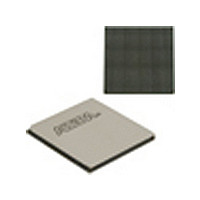EP4SGX530HH35C2N Altera, EP4SGX530HH35C2N Datasheet - Page 681

EP4SGX530HH35C2N
Manufacturer Part Number
EP4SGX530HH35C2N
Description
IC STRATIX IV FPGA 530K 1152HBGA
Manufacturer
Altera
Series
Stratix® IV GXr
Datasheets
1.EP4SGX110DF29C3N.pdf
(80 pages)
2.EP4SGX110DF29C3N.pdf
(1154 pages)
3.EP4SGX110DF29C3N.pdf
(432 pages)
4.EP4SGX110DF29C3N.pdf
(22 pages)
5.EP4SGX110DF29C3N.pdf
(30 pages)
6.EP4SGX110DF29C3N.pdf
(72 pages)
7.EP4SGX530HH35C2N.pdf
(1145 pages)
Specifications of EP4SGX530HH35C2N
Number Of Logic Elements/cells
531200
Number Of Labs/clbs
21248
Total Ram Bits
27376
Number Of I /o
564
Voltage - Supply
0.87 V ~ 0.93 V
Mounting Type
Surface Mount
Operating Temperature
0°C ~ 85°C
Package / Case
1152-HBGA
Family Name
Stratix® IV
Number Of Logic Blocks/elements
531200
# Registers
424960
# I/os (max)
560
Process Technology
40nm
Operating Supply Voltage (typ)
900mV
Logic Cells
531200
Ram Bits
28033024
Operating Supply Voltage (min)
0.87V
Operating Supply Voltage (max)
0.93V
Operating Temp Range
0C to 85C
Operating Temperature Classification
Commercial
Mounting
Surface Mount
Pin Count
1152
Package Type
FCHBGA
Lead Free Status / RoHS Status
Lead free / RoHS Compliant
Number Of Gates
-
Lead Free Status / Rohs Status
Compliant
Available stocks
Company
Part Number
Manufacturer
Quantity
Price
- EP4SGX110DF29C3N PDF datasheet
- EP4SGX110DF29C3N PDF datasheet #2
- EP4SGX110DF29C3N PDF datasheet #3
- EP4SGX110DF29C3N PDF datasheet #4
- EP4SGX110DF29C3N PDF datasheet #5
- EP4SGX110DF29C3N PDF datasheet #6
- EP4SGX530HH35C2N PDF datasheet #7
- Current page: 681 of 1154
- Download datasheet (32Mb)
Chapter 2: Transceiver Clocking in Stratix IV Devices
FPGA Fabric PLLs-Transceiver PLLs Cascading
FPGA Fabric PLLs-Transceiver PLLs Cascading
Table 2–5. Allowed Input Reference Clock Frequency for Example 1
February 2011 Altera Corporation
Multiplication
Factor (M)
10
16
20
25
2
4
5
8
Clock Output from Left and Right PLLs in the FPGA Fabric
You can use the synthesized clock output from one of the left or right PLLs to provide
the input reference clock to the CMU PLLs, 6G ATX PLLs, and receiver CDRs.
Stratix IV devices provide a dedicated clock path from the left PLLs (PLL_L1, PLL_L2,
PLL_L3, and PLL_L4) in the FPGA fabric to the PLL cascade network located on the left
side of the device. Stratix IV devices also provide a dedicated clock path from the
right PLLs (PLL_R1, PLL_R2, PLL_R3, and PLL_R4) in the FPGA fabric to the PLL
cascade network located on the right side of the device. The additional clock
multiplication factors available in the left and right PLLs allow more options for
on-board crystal oscillator frequencies.
The CMU PLL synthesizes the input reference clock to generate the high-speed serial
clock used in the transmitter PMA. The receiver CDR synthesizes the input reference
clock in lock-to-reference (LTR) mode to generate the high-speed serial clock.
This high-speed serial clock output from the CMU PLL and the receiver CDR runs at a
frequency that is half the configured data rate. The CMU PLLs and receiver CDRs
only support multiplication factors (M) of 2, 4, 5, 8, 10, 16, 20, and 25. If you use an
on-board crystal oscillator to provide the input reference clock through the dedicated
refclk pins or ITB lines, the allowed crystal frequencies are limited by the CMU PLL
and the receiver CDR multiplication factors. The input reference clock frequencies are
also limited by the allowed phase frequency detector (PFD) frequency range.
Example 1: Channel Configuration with a 4 Gbps Data Rate
Consider a channel configured for a 4 Gbps data rate. The high-speed serial clock
output from the CMU PLL and the receiver CDR must run at 2 Gbps.
the allowed input reference clock frequencies for Example 1.
For a 4 Gbps data rate, the Quartus II software only allows an input reference clock
frequency of 80, 100, 125, 160, 200, 250, 400, and 500 MHz. To overcome this limitation,
Stratix IV devices allow the synthesized clock output from the left and right PLLs in
the FPGA fabric to drive the CMU PLL and receiver CDR input reference clock. The
additional clock multiplication factors available in the left and right PLLs allow more
options for on-board crystal oscillator frequencies.
On-Board Crystal Reference Clock Frequency (MHz)
With /N = 1
1000
500
400
250
200
125
100
80
With /N = 2
2000
1000
800
500
400
250
200
160
Stratix IV Device Handbook Volume 2: Transceivers
No. Violates the PFD frequency limit.
No. Violates the PFD frequency limit.
Yes but only for /N = 1.
Allowed
Yes
Yes
Yes
Yes
Yes
Table 2–5
lists
2–9
Related parts for EP4SGX530HH35C2N
Image
Part Number
Description
Manufacturer
Datasheet
Request
R

Part Number:
Description:
CYCLONE II STARTER KIT EP2C20N
Manufacturer:
Altera
Datasheet:

Part Number:
Description:
CPLD, EP610 Family, ECMOS Process, 300 Gates, 16 Macro Cells, 16 Reg., 16 User I/Os, 5V Supply, 35 Speed Grade, 24DIP
Manufacturer:
Altera Corporation
Datasheet:

Part Number:
Description:
CPLD, EP610 Family, ECMOS Process, 300 Gates, 16 Macro Cells, 16 Reg., 16 User I/Os, 5V Supply, 15 Speed Grade, 24DIP
Manufacturer:
Altera Corporation
Datasheet:

Part Number:
Description:
Manufacturer:
Altera Corporation
Datasheet:

Part Number:
Description:
CPLD, EP610 Family, ECMOS Process, 300 Gates, 16 Macro Cells, 16 Reg., 16 User I/Os, 5V Supply, 30 Speed Grade, 24DIP
Manufacturer:
Altera Corporation
Datasheet:

Part Number:
Description:
High-performance, low-power erasable programmable logic devices with 8 macrocells, 10ns
Manufacturer:
Altera Corporation
Datasheet:

Part Number:
Description:
High-performance, low-power erasable programmable logic devices with 8 macrocells, 7ns
Manufacturer:
Altera Corporation
Datasheet:

Part Number:
Description:
Classic EPLD
Manufacturer:
Altera Corporation
Datasheet:

Part Number:
Description:
High-performance, low-power erasable programmable logic devices with 8 macrocells, 10ns
Manufacturer:
Altera Corporation
Datasheet:

Part Number:
Description:
Manufacturer:
Altera Corporation
Datasheet:

Part Number:
Description:
Manufacturer:
Altera Corporation
Datasheet:

Part Number:
Description:
Manufacturer:
Altera Corporation
Datasheet:

Part Number:
Description:
CPLD, EP610 Family, ECMOS Process, 300 Gates, 16 Macro Cells, 16 Reg., 16 User I/Os, 5V Supply, 25 Speed Grade, 24DIP
Manufacturer:
Altera Corporation
Datasheet:












